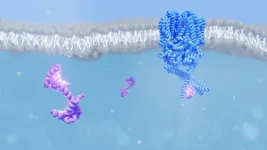(Press-News.org) HOUSTON – (April 3, 2023) – 2D materials get their strength from their atom-thin, sheetlike structure. However, stacking multiple layers of a 2D material will sap it of the qualities that make it so useful.
Rice University materials scientist Jun Lou and collaborators at the University of Maryland showed that fine-tuning interlayer interactions in a class of 2D polymers known as covalent organic frameworks (COFs) can determine the materials’ loss or retention of desirable mechanical properties in multilayer or bulk form. In the process, the researchers engineered a lightweight material with high stiffness and strength that preserves its 2D properties even as a multilayer stack, according to a study published in Proceedings of National Academy of Sciences.
The finding is a first step toward enabling the use of 2D polymers in large-scale multifunctional applications where mechanical properties are important and could open the door to new high-performance filtration systems, carbon capture and energy storage technologies.
“This to us is a very exciting starting point,” Lou said. “A really nice thing about COFs and other 2D polymers is that you have a lot of chemistry knobs you can tune. This means you can rationally engineer the interlayer interactions. Essentially, you can make very strong modular systems using interlayer interaction design.”
Researchers looked at how two COFs with very similar structures behave when multiple layers were stacked together and found that a small difference in their structure led to completely different patterns of interlayer interaction.
“In order to successfully design COFs with desirable interlayer interactions you need scientific insight into the material structures of COFs,” said Teng Li, a professor of mechanical engineering at Maryland. “To this end, we rely on first-principles simulations of the COF materials at the molecular scale to offer crucial design guidelines.”
Qiyi Fang, a Rice alum and co-lead author on the study, said the Rice lab designed two types of COFs based on the scientific insight from the simulations developed by colleagues at Maryland.
“One of the COFs, like most 2D materials, does not have a very strong interlayer interaction, and the strength and elasticity of the material decreases with the number of layers added,” Fang said. “The other COF, however, exhibits strong interlayer interaction and retains its good mechanical properties even with the addition of multiple layers.”
Maryland researcher and co-lead author Zhenqian Pang said the simulations helped pinpoint why the two COFs behaved differently.
“We found that the strong interlayer interaction in the latter COF results from the significantly enhanced hydrogen bonding among its special functional groups,” Pang said.
The fact that strong interactions between the 2D-material layers correlate with the persistence of desirable mechanical properties in the material’s multilayer or bulk form gives researchers a clue about what it takes to make a bulk-layered material that retains the mechanical properties of its 2D counterpart.
“We believe this strong interlayer interaction is primarily due to the chemistry of the hydrogen bond,” Lou said. “Hydrogen bonds are universal and occur in many systems. In our study, we show that those hydrogen bonds between layers are not only quite strong, but also dynamic in the sense that if they break under stress, they reform as the layers slide over one another.”
Facilitating stronger bonds between 2D-material layers can weaken the bonds connecting the atoms within a layer.
“Interlayer interaction-tuning is possible in other 2D materials, but what generally happens is you're going to sacrifice the strong in-plane bonding environment of those 2D materials in order to have those functional groups attached,” Lou said. “So it's actually a trade-off. With 2D polymers, you don't necessarily have to have that trade-off. That's one of the very important motivations for taking this direction in our research.”
A 2D polymer is made up of identical atom groupings with linking elements — the functional groups — along each of its edges.
“The 2D polymer is a sort of designer system, in the sense that it’s very tunable,” Lou said.
In previous research on 2D materials, Lou and collaborators had shown hexagonal boron nitride (h-BN) was 10 times more resistant to fracture than graphene.
“Like in graphene or h-BN, you still have this hexagonal lattice structure — six atoms in a hexagon pattern that you repeat indefinitely,” Lou said. “But for the 2D polymer, you also have a linker or nodal unit, which makes that hexagon larger.”
A larger repeat element means the material is less dense.
“This COF is nearly 10 times less dense than graphene or h-BN,” Fang said. “As a result, the specific strength and specific stiffness of the COF are among the highest reported.”
“This is significant because if we can show that this 2D material is as fracture-resistant as h-BN, it is also significantly lighter,” Lou added. “When you want greater strength without increasing the weight of your structure, this can be useful.
“This finding relates to some of the more application-driven ideas,” he said. “COFs could make excellent filtration membranes, for instance. Now we have a way to design very strong, very fracture-resistant, multilayer 2D polymers that could be very good candidates for membrane filtration applications.”
Lou said another potential application is for upgrading energy storage.
“We’ve already explored COF functionality for optimizing lithium-ion battery performance, and this shows we’re on the right track,” he said. “For all these applications, 2D polymers’ mechanical properties — especially in terms of fracture resistance — are very important.”
According to Li, the study’s key insight is that “tuning secondary intermolecular bonding is an effective materials-design strategy that could enable the development of an array of new materials with enhanced properties.
“This is distinct from the conventional materials design methods that rely largely on primary bonding,” he said. “There are fertile opportunities to design materials with this new strategy.”
Lou is a professor and associate department chair of materials science and nanoengineering at Rice.
The Army Research Laboratory (W911NF-18-2-0062), the Welch Foundation (C-1716) and the Maryland Advanced Research Computing Center supported the research.
-30-
This release can be found online at news.rice.edu.
Follow Rice News and Media Relations via Twitter @RiceUNews.
Peer-reviewed paper:
Superior mechanical properties of multi-layer covalent-organic-frameworks enabled by rationally tuning molecular interlayer interaction | Proceedings of the National Academy of Sciences | DOI: 10.1073/pnas.2208676120
Authors: Qiyi Fang, Zhengqian Pang, Qing Ai, Yifeng Liu, Tianshu Zhai, Doug Steinbach, Guanhui Gao, Yifan Zhu, Teng Li and Jun Lou
https://doi.org/10.1073/pnas.2208676120
Image downloads:
https://news-network.rice.edu/news/files/2023/03/230330_Jun-Lou-Qiyi-Fang_LG.jpg
CAPTION: Qiyi Fang (left) and Jun Lou stand beside a Langmuir-Blodgett trough. (Photo by Gustavo Raskosky/Rice University)
https://news-network.rice.edu/news/files/2023/03/230330_Jun-Lou-Qiyi-Fang_sample_LG.jpg
CAPTION: A sample of the covalent organic framework material (shown here on a silicone substrate) that researchers found preserves its 2D mechanical properties as a multilayer stack. (Photo by Gustavo Raskosky/Rice Unversity)
https://news-network.rice.edu/news/files/2023/03/230330_Jun-Lou_LG.jpg
CAPTION: Jun Lou is a professor and associate department chair of materials science and nanoengineering at Rice University. (Photo by Gustavo Raskoksy/Rice University)
https://news-network.rice.edu/news/files/2023/03/230330_Qiyi-Fang_LG.jpg
CAPTION: Qiyi Fang is a Rice alum and a lead author on the study. (Photo by Gustavo Raskoksy/Rice University)
Related stories:
Jun Lou receives Brimacombe Medal from Minerals, Metals and Materials Society:
https://msne.rice.edu/news/jun-lou-receives-brimacombe-medal-minerals-metals-and-materials-society
Hexagonal boron nitride’s remarkable toughness unmasked:
https://news.rice.edu/news/2021/hexagonal-boron-nitrides-remarkable-toughness-unmasked
Links:
Lou Group: http://n3lab.rice.edu/
George R. Brown School of Engineering: https://engineering.rice.edu
Located on a 300-acre forested campus in Houston, Rice University is consistently ranked among the nation’s top 20 universities by U.S. News & World Report. Rice has highly respected schools of Architecture, Business, Continuing Studies, Engineering, Humanities, Music, Natural Sciences and Social Sciences and is home to the Baker Institute for Public Policy. With 4,552 undergraduates and 3,998 graduate students, Rice’s undergraduate student-to-faculty ratio is just under 6-to-1. Its residential college system builds close-knit communities and lifelong friendships, just one reason why Rice is ranked No. 1 for lots of race/class interaction and No. 1 for quality of life by the Princeton Review. Rice is also rated as a best value among private universities by Kiplinger’s Personal Finance.
If you do not wish to receive news releases from Rice University, reply to this email and write “unsubscribe” in the subject line. Office of News and Media Relations – MS 300, Rice University, 6100 Main St., Houston, TX 77005.
END
Strong ultralight material could aid energy storage, carbon capture
2D polymers likely candidates for large-scale multifunctional applications
2023-04-03
ELSE PRESS RELEASES FROM THIS DATE:
Calcium sensor helps us to see the stars
2023-04-03
Using cryo-electron microscopy and mass spectrometry, researchers from PSI have deciphered the structure of an ion channel found in the eye while it interacts with the protein calmodulin – a structure that has eluded scientists for three decades. They believe that this interaction could explain how our eyes can achieve such remarkable sensitivity to dim light. Their results are published in the journal PNAS.
As you look at the bright screen of your phone or computer, ion channels in your eyes close in response to the light. This is the final step of a biochemical ...
New research could spur broader use of 2D materials
2023-04-03
They’re considered some of the strongest materials on the planet, but tapping that strength has proved to be a challenge.
2D materials, thinner than the most delicate onionskin paper, have attracted intense interest because of their incredible mechanical properties. Those properties, however, dissipate when the materials are stacked in multiple layers, thus limiting their usefulness.
“Think of a graphite pencil,” says Teng Li, Keystone Professor at the University of Maryland’s (UMD) Department of Mechanical Engineering. “Its core is made of graphite, and graphite ...
April issues of American Psychiatric Association journals cover genetic underpinnings of common disorders, a digital intervention for depression and anxiety in youth, and more
2023-04-03
WASHINGTON, D.C., April 3, 2023 — The latest issues of three of the American Psychiatric Association’s journals, The American Journal of Psychiatry, Psychiatric Services, and The American Journal of Psychotherapy, are now available online.
The April issue of The American Journal of Psychiatry features genetic, neuroimaging, and behavioral neuroscience studies that focus on the underpinnings of mood disorders, psychotic disorders, autism, and stress-related disorders. Highlights from the issue:
Lower Availability of Mitochondrial Complex I in Anterior Cingulate Cortex in ...
Royal reception on Commonwealth Day 2023 for Sri Lankan PhD researcher
2023-04-03
A PhD researcher from the University of Huddersfield’s Global Disaster Resilience Centre (GDRC) was invited by His Majesty The King and The Queen Consort to attend a special reception at Buckingham Palace and more, in celebration of Commonwealth Day 2023.
Malith Senevirathne is a PhD student at the GDRC, within the University’s School of Applied Sciences and a Research Assistant for the CORE project (sCience and human factOr for Resilient sociEty), funded by the European Commission. As ...
Can investigators use household dust as a forensic tool?
2023-04-03
A North Carolina State University-led study found it is possible to retrieve forensically relevant information from human DNA in household dust. After sampling indoor dust from 13 households, the researchers were able to detect DNA from household residents over 90% of the time, and DNA from non-occupants 50% of the time. The work could be a way to help investigators find leads in difficult cases.
Specifically, the researchers were able to obtain single nucleotide polymorphisms, or SNPs, from the dust samples. SNPs are sites within the genome that vary between individuals – corresponding ...
Center for AIDS Research receives $15 million renewal grant from NIH
2023-04-03
The National Institute of Allergy and Infectious Diseases (NIAID), part of the National Institutes of Health, has awarded a five-year, $15.45 million grant to the San Diego Center for AIDS Research (SD CFAR) at UC San Diego, renewing support that extends back to an original establishing grant in 1994 at the height of the AIDS epidemic.
"The grant renewal represents NIAID's continued and enduring investment in our mission to be a critical regional resource in HIV research and education, to advance the discovery and development of ...
Moderate exercise safe for people with muscle pain from statins
2023-04-03
Statin therapy does not exacerbate muscle injury, pain or fatigue in people engaging in moderate-intensity exercise, such as walking, according to a study published today in the Journal of the American College of Cardiology. The findings are reassuring for people who experience muscle pain or fatigue from statins but need to engage in physical activity to keep their cholesterol levels low and their hearts healthy.
Statins have long been the gold standard for lowering LDL or “bad” cholesterol ...
NC State researchers assemble pathogen ‘tree of life’
2023-04-03
A new online tool – the first of its kind for plant pathogens – will help researchers across the globe identify, detect and monitor species of Phytophthora, which have been responsible for plant diseases ranging from the devastating 1840s Irish potato famine to sudden oak death that still plagues West Coast oak population.
The new pathogen “tree of life” provides a plethora of information about each of the more than 192 formally described species – including their evolutionary history and relationships within groups – as well as more than 30 other informally described taxa. It also includes ...
National Institute of Dental and Craniofacial Research marks 75th anniversary
2023-04-03
Alexandria, VA – A symposium to kick off the year-long celebration of the 75th Anniversary of the National Institute of Dental and Craniofacial Research (NIDCR) was featured at the 52nd Annual Meeting & Exhibition of the AADOCR, held in conjunction with the 47th Annual Meeting of the CADR. The AADOCR/CADR Annual Meeting & Exhibition took place at the Oregon Convention Center in Portland on March 15-18, 2023.
The symposium explored a brief history of the founding of NIDCR and its early activities, followed by reflections of the former directors, Harold C. Slavkin, Lawrence A. Tabak and Martha ...
AADOCR announces 2023 AADOCR Hatton Competition and Award Winners
2023-04-03
Alexandria, VA – The American Association for Dental, Oral, and Craniofacial Research (AADOCR) has announced the winners of the 2023 AADOCR Hatton Competition. The winners were recognized during the Opening Ceremonies of the 52nd Annual Meeting of the AADOCR, which was held in conjunction with the 47th Annual Meeting of the Canadian Association for Dental Research (CADR), that took place on March 15, 2023.
The Hatton Award was first presented as the "Novice Award" in 1953 and is the oldest IADR/AADOCR ...
LAST 30 PRESS RELEASES:
Azacitidine–venetoclax combination outperforms standard care in acute myeloid leukemia patients eligible for intensive chemotherapy
Adding epcoritamab to standard second-line therapy improves follicular lymphoma outcomes
New findings support a chemo-free approach for treating Ph+ ALL
Non-covalent btki pirtobrutinib shows promise as frontline therapy for CLL/SLL
University of Cincinnati experts present research at annual hematology event
ASH 2025: Antibody therapy eradicates traces of multiple myeloma in preliminary trial
ASH 2025: AI uncovers how DNA architecture failures trigger blood cancer
ASH 2025: New study shows that patients can safely receive stem cell transplants from mismatched, unrelated donors
Protective regimen allows successful stem cell transplant even without close genetic match between donor and recipient
Continuous and fixed-duration treatments result in similar outcomes for CLL
Measurable residual disease shows strong potential as an early indicator of survival in patients with acute myeloid leukemia
Chemotherapy and radiation are comparable as pre-transplant conditioning for patients with b-acute lymphoblastic leukemia who have no measurable residual disease
Roughly one-third of families with children being treated for leukemia struggle to pay living expenses
Quality improvement project results in increased screening and treatment for iron deficiency in pregnancy
IV iron improves survival, increases hemoglobin in hospitalized patients with iron-deficiency anemia and an acute infection
Black patients with acute myeloid leukemia are younger at diagnosis and experience poorer survival outcomes than White patients
Emergency departments fall short on delivering timely treatment for sickle cell pain
Study shows no clear evidence of harm from hydroxyurea use during pregnancy
Long-term outlook is positive for most after hematopoietic cell transplant for sickle cell disease
Study offers real-world data on commercial implementation of gene therapies for sickle cell disease and beta thalassemia
Early results suggest exa-cel gene therapy works well in children
NTIDE: Disability employment holds steady after data hiatus
Social lives of viruses affect antiviral resistance
Dose of psilocybin, dash of rabies point to treatment for depression
Helping health care providers navigate social, political, and legal barriers to patient care
Barrow Neurological Institute, University of Calgary study urges “major change” to migraine treatment in Emergency Departments
Using smartphones to improve disaster search and rescue
Robust new photocatalyst paves the way for cleaner hydrogen peroxide production and greener chemical manufacturing
Ultrafast material captures toxic PFAS at record speed and capacity
Plant phenolic acids supercharge old antibiotics against multidrug resistant E. coli
[Press-News.org] Strong ultralight material could aid energy storage, carbon capture2D polymers likely candidates for large-scale multifunctional applications







